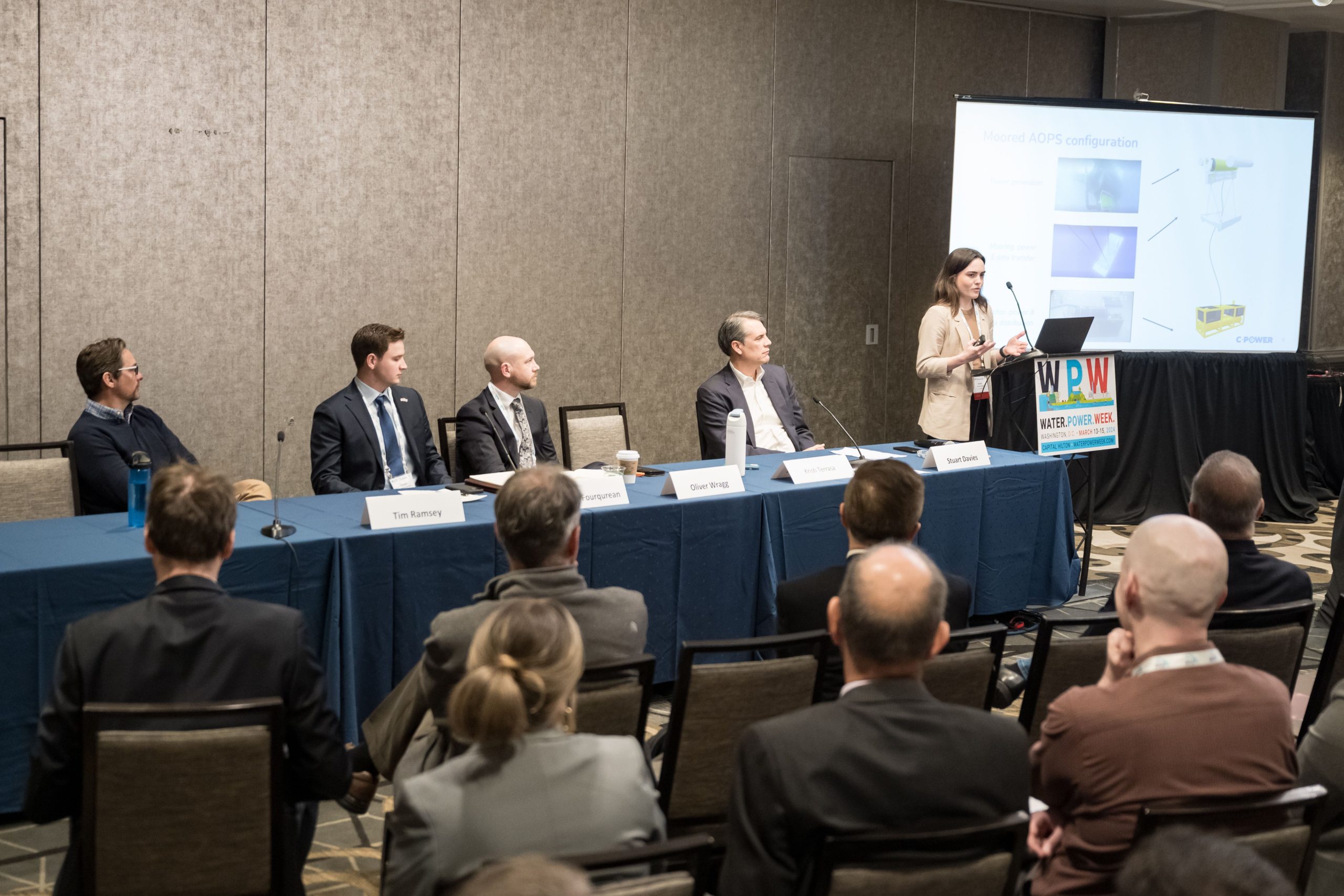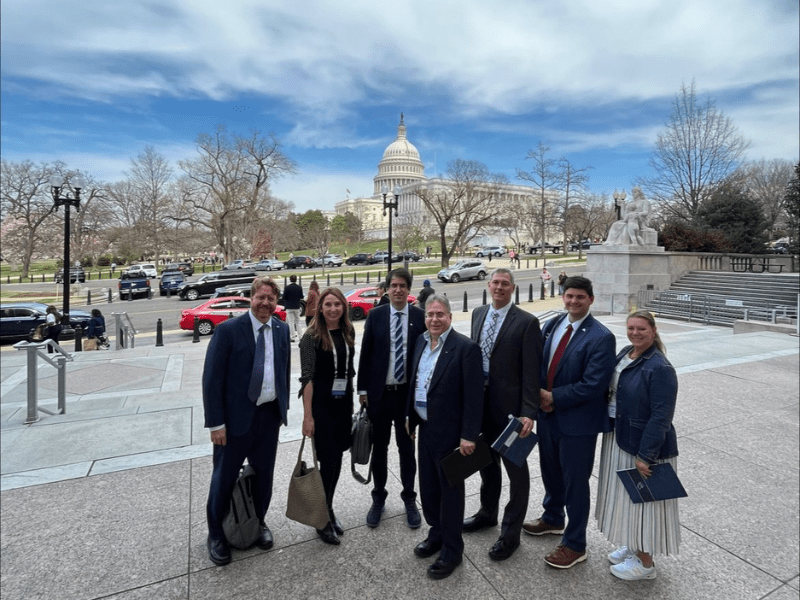At National Hydropower Association’s (NHA) Water Power Week, hydro project owners and water power developers, service and product suppliers, Congressional policymakers, government agency officials, non-government organizations (NGOs), and other stakeholders descended on Washington D.C. for intensive sessions covering many aspects of water power’s role in the clean energy future.
NHA, owner and organizer of the national policy conference, offers these observations and trends emerging from last week’s gathering.
The three takeaways from Water Power Week are:
- Marine Energy’s Critical Role in Supporting the Clean Energy Transition
- The Importance of Telling Water Power’s Story
- Hydropower as the Backbone of a Renewable Grid
MARINE ENERGY’S CRITICAL ROLE IN SUPPORTING THE CLEAN ENERGY TRANSITION
During the Friday plenary session at Water Power Week, Oliver Wragg, Commercial Director of Orbital Marine Power, detailed Orbital’s recent partnership with Orcas Power & Light Cooperative (OPALCO) to deploy an Orbital 02 floating tidal energy turbine in Washington State’s San Juan Islands. During the panel, Wragg remarked “We’re not here to run science experiments,” alluding to the tangible contributions marine energy technologies are already making to the clean energy future.
Building off last year’s momentum, which featured many achievements for the technology, including California becoming the first U.S. state to pass marine energy-centric legislation into law in over a decade, Water Power Week was abuzz with marine energy related content, featuring six sessions and one committee/council meeting devoted to the topic.
In the weeks leading up to Water Power Week, marine energy technologies received nearly $16 million from the Department of Energy (DOE). Of the nearly $16 million, $6 million was allocated to enabling a tidal energy research, development, and pilot site in the United States; additionally, a community-led river current energy research and development project was selected to receive $9.5 million.

Orbital Marine’s O2 tidal energy turbine
The nearly $16 million in marine energy funding is supported by the Bipartisan Infrastructure Law (BIL), and it encourages U.S. leadership to continue pursuing tidal and current energy developments by utilizing the United States’ abundance of marine energy resources. According to a 2021 study conducted by National Renewable Energy Laboratory (NREL), the technical resource potential of marine energy in the U.S. was estimated to be 2,300 terra-watt hours (TWh) per year, which is equivalent to 57% of the electricity generated in the U.S. in 2019.
Tapping into this resource was the subject of much discussion at Water Power Week, and to gain perspective into how domestic marine energy technology developers can make critical gains, NHA featured a session titled “Marine Energy: What Can We Learn from What’s Happening Around the World?” While there were a plethora of takeaways from this session, the standouts were as follows:
- Consistent funding is flowing into the international marine energy sector, helping move the technology forward.
- Communication is critical between industry and federal agencies to create and implement the pathway to commercialization.
- The marine energy industry needs to highlight and communicate its successes to raise the visibility of the technologies. Narratives help inspire the public to support marine energy and in turn, push governments to create pathways for development.
- Pilot deployments are necessary to grow the U.S. marine energy industry. Deployments enable companies to collect data, which in turn helps inform lessons learned, improve component optimization, and build investor confidence.

Kristi Terrasa, Senior Associate of Corporate & Business Development at C-Power, addresses attendees of the “Marine Energy: What Can We Learn from What’s Happening around the World?” session, which featured (from left to right): Tim Ramsey, Marine Energy Program Manager at WPTO, Robert Fourqurean, Policy Advisor – Energy and Climate for the British Embassy, Oliver Wragg, Commercial Director at Orbital Marine Power, and Stuart Davies, CEO of ORPC, inc
The marine energy content at Water Power Week also explored how the technology can do more than traditional power production, focusing on its “at-sea” capabilities, which cover powering ocean monitoring devices, charging underwater autonomous vehicles (UAVs) used for national security, and providing a localized power source after natural disasters. These wide-ranging applications are attractive opportunities for developers because of the federal funding already available for development and deployment of technologies designed for these and other national security applications.
Understanding the importance of marine energy, and with a shared vision of harnessing the technology’s potential to help achieve net zero globally, NHA signed a Memorandum of Understanding (MOU) with Marine Renewables Canada (MRC) earlier this month to enhance collaboration and knowledge-sharing in the development of marine energy resources.
Speaking to the critical nature of this partnership, Malcolm Woolf, NHA’s President and CEO, said, “By working more closely with Marine Renewables Canada, we hope to collaborate on key challenges, build partnerships amongst our memberships, and share information and best practices that can help accelerate the sector’s development.”
THE IMPORTANCE OF TELLING WATER POWER’S STORY
Water power has a great story to tell, and these narratives – built around clean energy, reliability, and community – are getting the industry noticed the more widely they’re shared. This year’s Water Power Week sought to celebrate and build upon this progress.
At Wednesday’s plenary session, NHA President and CEO, Malcolm Woolf, proudly debuted NHA’s latest digital ad campaign aimed at illuminating the promise and potential of hydro to key audiences. This year’s ad, which is entitled “The Solution That’s Right in Front of You,” positions water power as an important answer to critical questions about how to power and bolster a 24/7 reliable, clean energy grid.
Starting this month, the ad will be broadcast to Washington D.C.- area policymakers and national climate thought leaders on social media, streaming platforms, and online news outlets. In an election year, one with so much at stake, the campaign seeks to place water power top-of-mind for the important decision makers leading the energy transition.
The unveiling of this bold, new campaign helped hype-up attendees for another important part of telling water power’s story – Advocacy Day on Capitol Hill. One component of Wednesday’s robust Advocacy Days efforts consisted of several “Tiger Teams,” which headed to the U.S. Capitol Complex to meet with key congressional offices in the House and Senate. These lawmakers were chosen because of their importance to the industry, either as the representative of a state or district that depends heavily on water power, a member of a key congressional committee, or a leader in their respective party.

One of the Advocacy Day “Tiger Teams” poses for a photo outside the U.S. Capitol Building
When everything was said and done, over 100 industry professionals visited more than 80 Congressional offices, where they shared personal stories about why water power matters to them. Importantly, these conversations didn’t just focus on data and numbers, but were also punctuated by examples of hydro’s contribution to community, diversity, and the American dream.
It’s safe to say that these meetings were a major success due to the connections made and narratives shared. In the world of congressional advocacy, simply showing up with a compelling story is half the battle for recognition. One congressional staffer, who an advocacy team met with, put it more brashly, remarking, “If you’re not at the table, then you’re on the menu.”

An Advocacy Day “Tiger Team” meets with Alice Lin, Tax Policy Advisor for the Senate Financial Committee
HYDROPOWER AS THE BACKBONE OF A RENEWABLE GRID
During Water Power Week’s final plenary session on Friday morning, Herbie Johnson, Technology Manager at DOE, made an observational remark about the “uniqueness” of the panel he was moderating; specifically, Johnson was commenting about a historical first for Water Power Week, as never before had hydropower, hydrogen, and tidal energy representatives shared the stage.
In many ways, the “uniqueness” of the panel’s composition was emblematic of hydropower’s role in the clean energy transition – a thematic element which permeated nearly every session, presentation, and conversation at Water Power Week.

Herbie Johnson (left), Technology Manager at DOE, moderates the Friday morning plenary session, featuring (from right to left) Oliver Wragg, Commercial Director of Orbital Marine, Gary Ivory, General Manager at Douglas County PUD, and Gia Schneider, Co-Founder and CEO of Natel Energy
Friday’s keynote speaker, Jason Grumet, CEO of the American Clean Power Association, pulled at this thread further, recognizing hydro’s ability to leap-in during extreme weather events, calling it “the unsung hero of the clean energy transition” while stressing the need for all renewables to work together in pursuit of the clean energy future.

Jason Grumet, CEO of American Clean Power Association, addresses attendees during Water Power Week’s final plenary session
Last year, NREL released a report titled “The Role of Hydropower Flexibility in Integrating Renewables in a Low-Carbon Grid,” which examined hydro’s flexibility as it relates to integrating variable renewable energy. The study found that the firm capacity associated with hydropower’s flexibility is estimated to be more than 24 GW, and to replace this capability with its storage equivalent would require the buildout of over 24 GW of 10-hour storage, exceeding the entirety of all existing long-duration storage currently available in the U.S.
Grumet further built upon this data in his keynote, highlighting the need for renewables to develop strategy together as the clean power sector gets to scale. This point was repeated in various forms throughout Water Power Week.
At Friday morning’s “Pumped Storage Development Council Meeting,” Rocío Uría-Martínez, R&D Staff Member in the Environmental Risk and Energy Analysis Group at Oak Ridge National Laboratory, discussed some of the key findings from DOE’s “U.S. Hydropower Market Report 2023 Edition.”
The “U.S. Hydropower Market Report,” which reflects on the trends shaping the hydropower industry, presents analysis of hydro data, offering actionable items the industry could undertake in a variety of areas. One such opportunity for inter-renewable collaboration includes increased partnership with the wind energy industry due to shared steel casting needs. The report outlines how greater dialogue between the industries would allow for increased strength in the pooling of demands, which would help identify manufacturing opportunities in the U.S while demonstrating the domestic demand for said services and materials.
Hydropower’s benefits were also the subject of multiple remarks by top officials from DOE, including Thursday’s keynote speaker, Maria Robinson, Director of DOE’s Grid Deployment Office, who said, “There is no reality where the U.S. reaches the clean energy future without the contributions of hydropower.”

Maria Robinson, Director of DOE’s Grid Deployment Office, addresses attendees at Thursday’s morning plenary session at Water Power Week
NREL’s recent “Hydropower Investment and Public-Private Ecosystem Assessment” report is in agreement, as the findings identified one of the top areas of investor interest to be hybrid plant configuration; specifically, the utilization of hydro in a hybrid configuration with other renewables as a means of unlocking new revenue streams by providing power during peak demand.
Robinson also utilized her keynote to announce the opening of the Hydroelectric Production Incentives, which has provided almost $90 million in incentive payments for hydroelectricity generated and sold since 2014. Applications for the program are due by 5:00 PM ET on April 23, 2024.
FOR MORE INFORMATION
For a full review of the Water Power Week in Washington 2023 conference program and speaker lineup, visit the event website.













